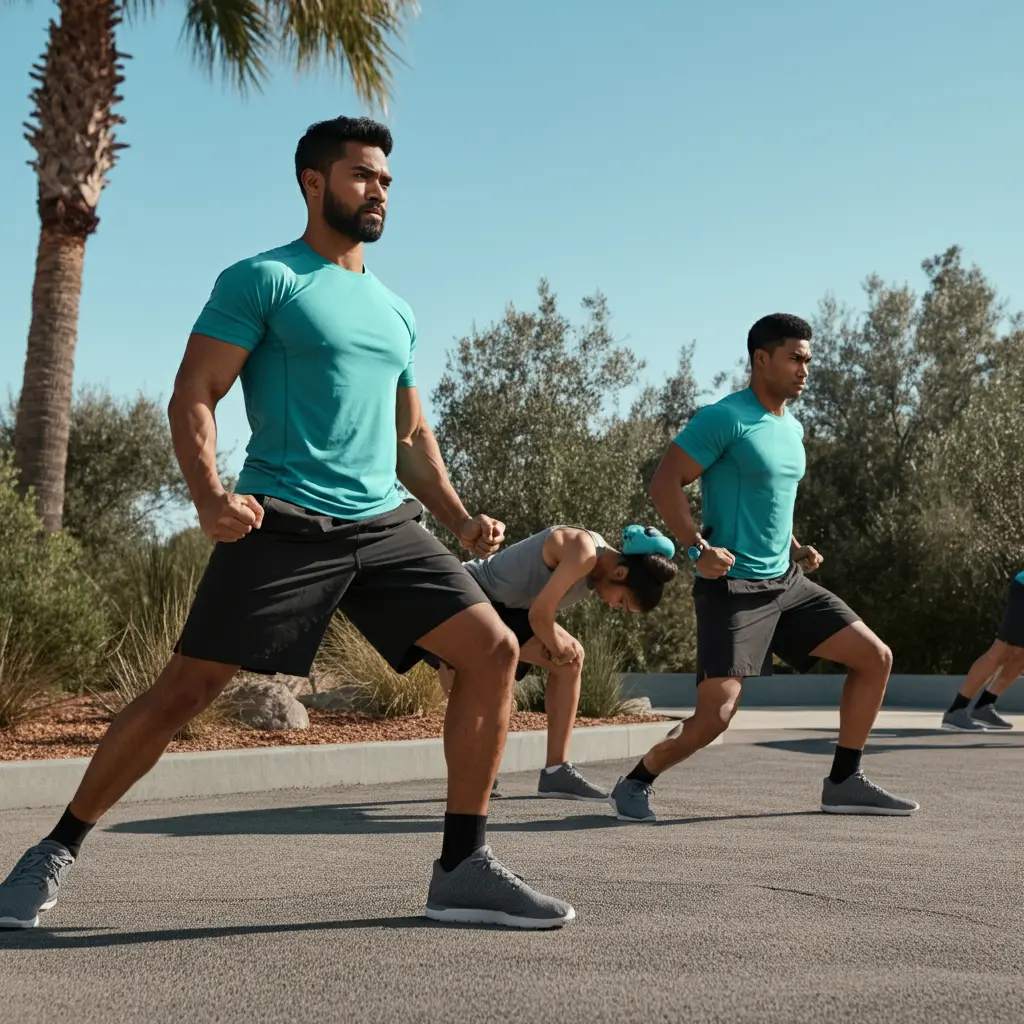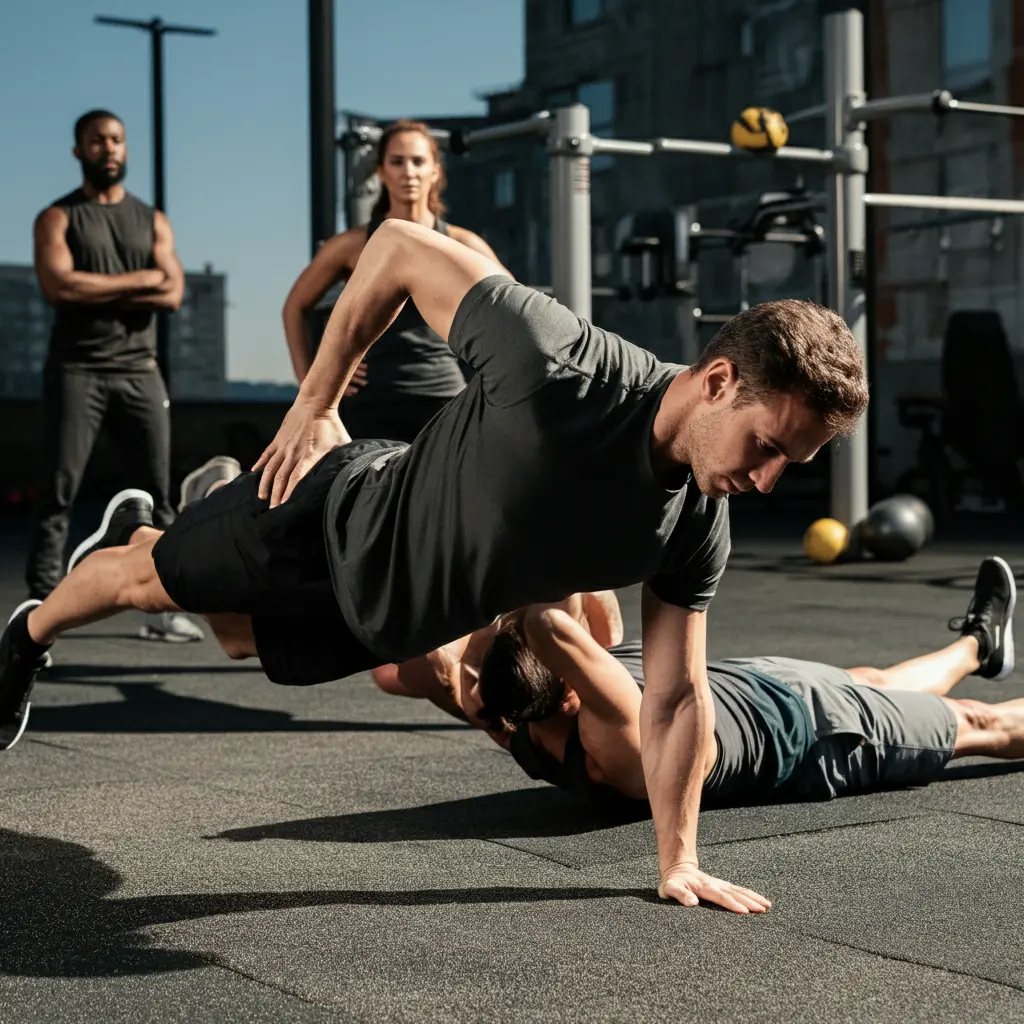H2 – Opening: From “Maybe Tomorrow” to Your First Pull-Up(How to Get Into Calisthenics)
You scroll past another gravity-defying front-lever on Instagram and feel a mix of awe and I-could-never-do-that. Yet here you are, reading this guide because a little voice keeps whispering that your body is capable of far more than sit-all-day posture and once-a-week treadmill guilt. I remember lying on my apartment floor, elbows trembling as I chased a single knee push-up after months of pandemic inertia. When my chest finally touched the carpet, something clicked: fitness isn’t locked inside expensive machines—it’s written into your DNA. Calisthenics turns that code back on. By the time you finish this article you’ll own a blueprint that carries you from absolute beginner to confident body-weight athlete—no gym membership, no guesswork, just you, your resolve, and the floor beneath your feet. (How to Get Into Calisthenics)
Table of Contents
H2 – Why Start Calisthenics for Full-Body Fitness?
H3 – Science-Backed Benefits of Body-Weight Training
(How to Get Into Calisthenics)
- Muscle & Strength Gains Rival Free Weights – Modern research shows that manipulating leverage, tempo, and volume can provoke muscle growth comparable to traditional resistance training us.humankinetics.com.
- Higher Workout Adherence – Participants in home-based programs maintain roughly 70 % adherence, largely because travel time and equipment barriers vanish pmc.ncbi.nlm.nih.gov.
- Metabolic & Mobility Perks – Body-weight circuits improve lipid profiles, liver function, and overall quality of life, even in overweight beginners pmc.ncbi.nlm.nih.gov.
H3 – Calisthenics vs. Traditional Gym Workouts
- Cost & Convenience – Your “equipment” is a wall, a floor, and perhaps a playground bar.
- Functional Strength – Compound moves teach your muscles to fire as integrated systems, not isolated parts.
- Time Efficiency – Superset-style sessions slash workout length without sacrificing hypertrophy or power pubmed.ncbi.nlm.nih.gov.
- Anywhere Access – Hotel room, park, dorm, or office break room—where your body fits, calisthenics follows.


H2 – Setting the Foundation: Beginner Calisthenics Basics
H3 – Assess Your Current Fitness Level
(How to Get Into Calisthenics)
- Plank Hold – Can you maintain a rigid plank for 30 seconds?
- Body-Weight Squat – Does your hip crease drop below your knees without your heels lifting?
- Bar Hang – Time how long you can simply hang; this grip metric guides your pull-up progression.
Tip: Write these numbers down. Baseline data fuels motivation when the dog days hit.
H3 – Core Movement Patterns You Must Master
| Pattern | Starter Exercise | Goal Variation | Key Cues |
|---|---|---|---|
| Push | Incline push-up | Decline push-up | Hands under shoulders, elbow angle ≈ 45° |
| Pull | Doorway row | Full pull-up | Lead with chest, depress scapula first |
| Squat | Air squat | Jump squat | Knees track toes, spine neutral |
| Core | Dead bug | Hanging knee raise | Lower back glued to floor (or bar) |
H4 – Five-Minute Mobility Warm-Up
- Cat-cow (thoracic spine)
- Wrist circles (push-up health)
- Hip flexor stretch
- World’s greatest stretch
- Scapular push-ups
H2 – Building Your First Routine (How to Get Into Calisthenics)
H3 – Progressive Overload Without Weights
Muscle fibers respond to stress, not steel. You’ll increase tension by (a) shifting leverage—elevating your feet for push-ups, moving hands forward for planks; (b) slowing the eccentric phase to boost time under tension; and (c) adding sets or reps. These three levers create infinite difficulty gradients rumen.com.au.
Pro Rule: When you can complete the top rep range with impeccable form for two sessions in a row, level-up the movement.
H3 – 4-Week Beginner Blueprint
| Week | Push | Pull | Legs | Core / Accessory | Volume |
|---|---|---|---|---|---|
| 1 | Incline push-up | Doorway row | Air squat | Dead bug | 3 × 8 |
| 2 | Knee push-up | Table row | Split squat | Hollow hold | 3 × 10 |
| 3 | Full push-up | Negative pull-up | Goblet squat* | Plank shoulder tap | 4 × 8 |
| 4 | Decline push-up | Band-assisted pull-up | Jump squat | Hanging knee raise | 4 × 10 |
*Load a backpack with books if you don’t own dumbbells.
Perform this routine three non-consecutive days per week. Rest 60–90 seconds between sets.
H3 – Nutrition & Recovery Made Simple (How to Get Into Calisthenics)
| Recipe | Ingredients (per serve) | Why It Helps |
|---|---|---|
| Greek-Yogurt Parfait | 170 g Greek yogurt, 1 tbsp honey, 30 g oats, 50 g berries | 20 g complete protein accelerates muscle repair; antioxidants combat oxidative stress chobani.com |
| Chickpea Power-Bowl | 120 g chickpeas, 1 cup spinach, ½ avocado, 1 tbsp olive oil, lemon juice | Plant protein + monounsaturated fats support joint health |
| Post-Workout Smoothie | 1 banana, 30 g whey, 250 ml milk of choice, 5 g cocoa powder | Quick carbs & protein restore glycogen and initiate recovery |
Aim for 1.6–2.2 g protein/kg body weight daily; hydrate 30 ml/kg.
H2 – Mastering Technique & Preventing Injury
H3 – Form Checkpoints (How to Get Into Calisthenics)
- Push-Up – Engage glutes/core; body forms a straight line; chest—not stomach—hits first.
- Pull-Up – Drive elbows to ribs; avoid “shrug” by keeping shoulder blades down and back.
- Squat – Sit between, not on top of your knees; push floor apart to keep knees out.
H3 – Common Mistakes & Quick Fixes
| Mistake | Why It Hurts Progress | Fix |
|---|---|---|
| Sagging hips in push-up | Overloads lumbar spine | Elevate hands until core control improves |
| Elbows flare > 60° | Anterior-shoulder strain | Tuck elbows to 45°; use narrower grip |
| Greedy volume jump | Overuse injuries | Follow the 10 % rule: never add more than 10 % total reps week-to-week |
H2 – Level-Up Strategies
H3 – Leveraging Leverage (How to Get Into Calisthenics)
- Front Lever Path – Tuck → Advanced tuck → One-leg → Straddle → Full front lever.
- Planche Path – Frog stand → Tuck planche → Straddle planche.
- Add pause reps (2–3 s) at sticking points to carve neural pathways faster.
H3 – Smart Equipment Upgrades
- Doorframe Pull-Up Bar – <$30, installs in seconds.
- Gymnastic Rings – Rotating handles reduce joint stress and multiply exercise variations.
- Parallettes – Higher wrist comfort during deep push-ups, L-sits, and swing work.
H3 – Tracking Progress (How to Get Into Calisthenics)
- Analog – Spiral notebook with date, exercise, sets, reps, RPE.
- Digital – Apps like Madbarz, Thenics, or simple Google Sheets.
- Re-test max push-ups, pull-ups, and hollow-hold time every 4 weeks.
H2 – Lifestyle Integration (How to Get Into Calisthenics)
H3 – Time-Efficient HIIT Circuits
Try a 4-minute Tabata: 20 s burpees / 10 s rest × 8 rounds. HIIT protocols demonstrate significant VO₂ max gains across multiple meta-analyses pubmed.ncbi.nlm.nih.gov—delivering cardio health in a bite-sized window.
H3 – Motivation Through SMART Goals
- Specific – “Perform 5 strict pull-ups.”
- Measurable – Video each testing week.
- Achievable – Use band assistance until you hit 3 unassisted reps.
- Relevant – Pull-ups unlock tougher calisthenic skills.
- Time-Bound – “By Week 10.”
H3 – Community & Resources (How to Get Into Calisthenics)
- Reddit r/Calisthenics – Technique critiques, progression charts.
- YouTube Channels – CaliMove and MinusTheGym offer free tutorials youtube.com.
- ACE Fitness Database – Evidence-based exercise breakdowns.
H2 – FAQ: How to Get Into Calisthenics
Q1. Is calisthenics enough for overall fitness?
Yes. When you hit all main movement patterns and incorporate short HIIT circuits, you achieve strength, mobility, and cardio conditioning without external weights.
Q2. How long before I see muscle gains?
Novices typically notice visible changes in 4–6 weeks and measurable strength improvements after 2 weeks of consistent overload.
Q3. Do I need supplements to start calisthenics fitness routines?
Whole foods can meet all needs, but whey protein or creatine simplify hitting targets—especially if your schedule is hectic.
Q4. Can calisthenics replace cardio in my fitness plan?
Dynamic body-weight circuits elevate heart rate similar to running; pairing skill sessions with HIIT meets standard cardio guidelines.
Q5. What if I can’t do a single push-up—where do I begin?
Start with wall push-ups, progress to incline push-ups on a bench, then floor kneeling versions. Add tension slowly and celebrate every micro-win.
H2 – Conclusion: Your Fitness Future Starts With One Rep
(How to Get Into Calisthenics)
Every advanced athlete you admire once stared at the floor, wondering if their arms would catch them. Your journey into calisthenics—and lifelong fitness—begins the moment you choose to chase mastery over mirrors. Bookmark this plan, write tomorrow’s workout in ink, and share your first sweaty victory selfie with the hashtag #FirstRepForward. Momentum loves company, and your story might be the spark that lights someone else’s path. Now drop down and give yourself five—your future self is already cheering. (How to Get Into Calisthenics)
call to action
Ready to commit? Download our free printable workout log and tag @CalisthenicsStart on Instagram with your Day 1 plank time. You’ll be entered to win a pair of premium gymnastic rings—perfect for your Week 4 upgrade. Let’s build this community one rep at a time!


